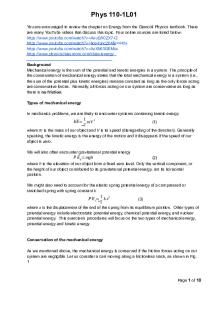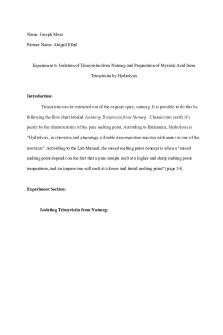Lab report 5 Bhakti Patel PDF

| Title | Lab report 5 Bhakti Patel |
|---|---|
| Author | Bhakti Patel |
| Course | General Chemistry I |
| Institution | Arkansas State University |
| Pages | 4 |
| File Size | 190.3 KB |
| File Type | |
| Total Downloads | 41 |
| Total Views | 133 |
Summary
This the lab report ...
Description
Stoichiometry of a Precipitation Reaction CHEM 1014 Bhakti Patel
Introduction The purpose of this experiment is to familiarize us with precipitation reactions and how to use stoichiometry to calculate the theoretical yield of reactants. The other objective is to teach us how to calculate the percentage yielding of a product that is produced. Knowledge of conducting and experiment where two reactants form a precipitate and how you have to properly identify their part of that chemical reaction. It also helps us to identify accurate measurements and how to calculate. We need to be familiar with laboratory equipment. Materials and Methods For this experiment we will be using distilled water, dish soap, paper towel, funnel, scale, 100 ml beaker, graduated cylinder, and other materials. We can find these all under the procedure that is lined by the hands-on lab(2015). It is important to wear safety goggles and gloves when dealing with chemicals. For this exercise, I measured my distilled water that was 25ml and poured it into each glass. Weighted the plastic boat on the digital scale which consisted of 2.0 g CaCl2 2H2O. Then this solution was added to one of the beakers with water and calculated it in moles. The data was recorded for this exercise in the table. The same steps were repeated but this time with Na2CO3. The solution was placed in a filter paper. Lastly, the mass of the precipitates was calculated Results
I allowed the substance to precipitate for some time and it seemed like the chemicals lost some of its initial weight. Besides, stoichiometry can be used o determine the product formed in the reaction, and we can also know how reactant is required for each reactant that can be used at the same time. For stoichiometry, we must always consider that “ make sure your equation is balanced! If the equation is not balanced, the mole ratios will be wrong, and the answers will not be correct.” Lastly, their quantities can also be used to maximize the number of products that are formed from the chemical reaction.
Citation Chang, R., & Goldsby, K. A. (2016). Chemistry: Raymond Chang and Kenneth A. Goldsby. New York: McGraw-Hill Education. Hands-On Labs. (2015). HOL Courseware and Resources. Denver, CO.
“Stoichiometry: Stoichiometric Ratio Examples (Article).” Khan Academy, Khan Academy, www.khanacademy.org/science/chemistry/chemical-reactions-stoichiome/stoichiometry-
ideal/a/stoichiometry....
Similar Free PDFs

Lab report 5 Bhakti Patel
- 4 Pages

Lab Report 2 Bhakti Patel
- 9 Pages

Lab report 3 Bhakti Patel(Actual)
- 10 Pages

LAB 5 - Lab report
- 4 Pages

Lab Report 5 - lab
- 5 Pages

Lab 5 - Lab report
- 6 Pages

Lab 5 - Lab experiment report
- 6 Pages

Lab 5 Lab Report- (Microbiology)
- 4 Pages

Phys lab 5 - Lab report
- 10 Pages

Experiment 5 - Lab Report 5
- 16 Pages

Post Lab Report Lab 5
- 5 Pages

Lab 5 Report
- 5 Pages

Chem lab report 5
- 7 Pages

Lab 5 Report
- 8 Pages

EX 5 lab report
- 10 Pages

Lab Report 5
- 8 Pages
Popular Institutions
- Tinajero National High School - Annex
- Politeknik Caltex Riau
- Yokohama City University
- SGT University
- University of Al-Qadisiyah
- Divine Word College of Vigan
- Techniek College Rotterdam
- Universidade de Santiago
- Universiti Teknologi MARA Cawangan Johor Kampus Pasir Gudang
- Poltekkes Kemenkes Yogyakarta
- Baguio City National High School
- Colegio san marcos
- preparatoria uno
- Centro de Bachillerato Tecnológico Industrial y de Servicios No. 107
- Dalian Maritime University
- Quang Trung Secondary School
- Colegio Tecnológico en Informática
- Corporación Regional de Educación Superior
- Grupo CEDVA
- Dar Al Uloom University
- Centro de Estudios Preuniversitarios de la Universidad Nacional de Ingeniería
- 上智大学
- Aakash International School, Nuna Majara
- San Felipe Neri Catholic School
- Kang Chiao International School - New Taipei City
- Misamis Occidental National High School
- Institución Educativa Escuela Normal Juan Ladrilleros
- Kolehiyo ng Pantukan
- Batanes State College
- Instituto Continental
- Sekolah Menengah Kejuruan Kesehatan Kaltara (Tarakan)
- Colegio de La Inmaculada Concepcion - Cebu